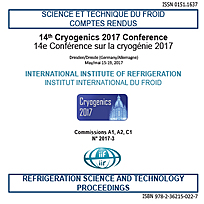
Document IIF
Analyse énergétique et exergétique de l’usage d’air liquide pour le conditionnement d’air et la production d’électricité pour des bâtiments résidentiels.
Energy an exergy analysis of using liquid air for generating air conditioning and power for domestic buildings.
Numéro : pap. n. 0094
Auteurs : ABDALQADER A., RAYA Al-D., SAAD M.
Résumé
Conventional air conditioning systems consume significant amount of energy particularly during the peak period, and cold energy storage in form of liquid Air (LAir), which is produced using renewable energy sources or surplus electricity at the off-peak period, is anticipated as an alternative technique that provides air conditioning as well as generating power for domestic and/or industrial applications. Therefore, the current work presents energetic and exergetic analysis of a combined cryogenic cycle that fuelled by LAir and uses the building cooling load as heat source. The analysis was carried out from thermodynamic point view using MATLAB combined with REFPROP software. Results showed that, using LAir to provide air conditioning and power is a promising technique leads to save energy and to reduce the peak electricity demands. The cycle the thermal and exergy efficiencies reached 47 % and 59 %, respectively. Considering the two energies output (cooling and power) more than 65 % of the LAir energy production was recovered.
Documents disponibles
Format PDF
Pages : 8 p.
Disponible
Prix public
20 €
Prix membre*
Gratuit
* meilleur tarif applicable selon le type d'adhésion (voir le détail des avantages des adhésions individuelles et collectives)
Détails
- Titre original : Energy an exergy analysis of using liquid air for generating air conditioning and power for domestic buildings.
- Identifiant de la fiche : 30021752
- Langues : Anglais
- Source : Cryogenics 2017. Proceedings of the 14th IIR International Conference: Dresden, Germany, Mai 15-19, 2017.
- Date d'édition : 15/05/2017
- DOI : http://dx.doi.org/10.18462/iir.cryo.2017.0098
Liens
Voir d'autres communications du même compte rendu (71)
Voir le compte rendu de la conférence
Indexation
-
Cryogenics for space exploration.
- Auteurs : SALERNO L. J.
- Date : 17/07/2006
- Langues : Anglais
- Source : Multiconference CryoPrague 2006 (9th Cryogenics 2006, ICEC 21, ICMC'06)
- Formats : PDF
Voir la fiche
-
Analytical model for a leak detection system on...
- Auteurs : ABDALQADER A., RAYA Al-D., SAAD M.
- Date : 15/05/2017
- Langues : Anglais
- Source : Cryogenics 2017. Proceedings of the 14th IIR International Conference: Dresden, Germany, Mai 15-19, 2017.
- Formats : PDF
Voir la fiche
-
Cryocooler to cryogen tank interface.
- Auteurs : KITTEL P.
- Date : 17/07/2006
- Langues : Anglais
- Source : Multiconference CryoPrague 2006 (9th Cryogenics 2006, ICEC 21, ICMC'06)
- Formats : PDF
Voir la fiche
-
Innovative hybrid mechanical and cryogenic syst...
- Auteurs : YOUBI-IDRISSI M.
- Date : 11/04/2022
- Langues : Anglais
- Source : 7th IIR International Conference on Sustainability and the Cold Chain (Online). Proceedings: April 11-13 2022
- Formats : PDF
Voir la fiche
-
Cryogenics-based energy storage concepts: evalu...
- Auteurs : HAMDY S., MOROSUK T., TSATSARONIS G.
- Date : 15/05/2017
- Langues : Anglais
- Source : Cryogenics 2017. Proceedings of the 14th IIR International Conference: Dresden, Germany, Mai 15-19, 2017.
- Formats : PDF
Voir la fiche
